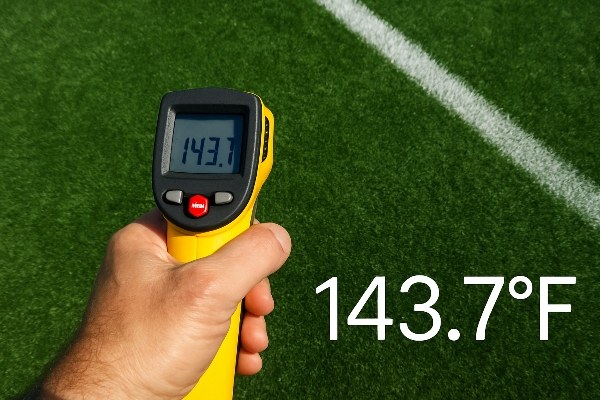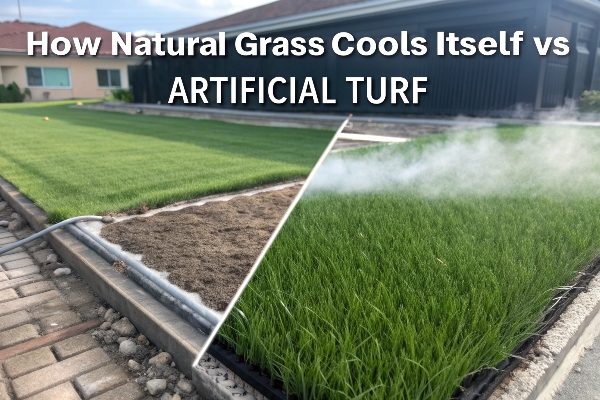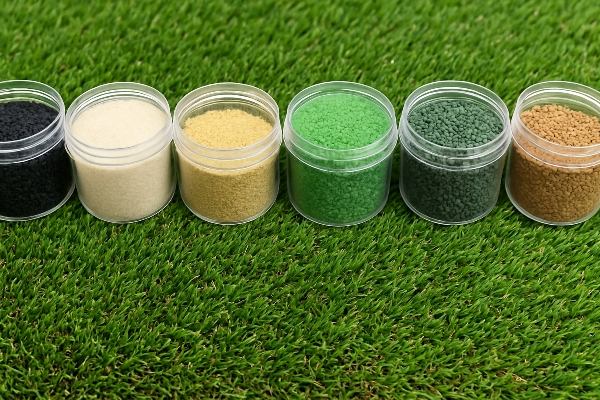Worried your new artificial lawn will be too hot to use in summer? This heat can be a real problem for families and pets, but simple solutions exist.
Artificial grass can get 35-60°F (20-33°C) hotter than the air temperature. On a hot day, its surface can reach 150-180°F (65-82°C), significantly warmer than natural grass, but manageable with the right product choices and cooling methods.

I’ve spent years working with artificial turf, from the factory floor to helping clients build successful businesses. I have seen firsthand how heat can be a major concern for buyers. But I have also learned that it does not have to be a deal-breaker. Understanding why it gets hot is the first step to solving the problem. Let’s break it down so you can make the best choice for your project.
Does Artificial Grass Heat Up in the Sun?
You’ve seen beautiful artificial lawns, but wonder about the heat. If it gets too hot, it becomes unusable. Luckily, understanding this is simple, and so is managing it.
Yes, artificial grass definitely heats up in direct sunlight. Because it’s made from synthetic materials like plastic and has a rubber infill, it absorbs and retains solar radiation much more than natural grass, which has a natural cooling mechanism.

I remember a client in a very sunny region who was hesitant about turf for a playground project. He was right to be cautious. Unlike natural grass, which cools itself through a process called evapotranspiration1 (releasing water vapor), artificial turf just sits there and soaks up the sun’s energy.
Key Factors in Heat Absorption
The main components contributing to heat are:
- The Blades (Fibers): Usually made of polyethylene, polypropylene, or nylon. Darker colors absorb more light and heat.
- The Infill: This is the big one. Traditional black crumb rubber (SBR) is notorious for getting extremely hot.
- The Backing: The base layer of the turf also holds some heat.
Think of it like a dark-colored car parked in the sun versus a light-colored one. The dark one gets much hotter, faster. The same principle applies here. Different materials and colors have different heat properties, a crucial detail for any project in a warm climate.
Why Does Artificial Turf Heat Up Faster Than Natural Grass?
Confused why your fake grass feels so much hotter than real grass? This temperature difference can ruin a summer afternoon. The reason lies in their very different compositions.
Natural grass is about 85% water. It uses evapotranspiration to actively cool itself, like sweating. Artificial turf is a non-living surface made of plastic and rubber that lacks this ability. It simply absorbs and holds the sun’s heat.

During my early days as an engineer, I was fascinated by the thermal properties of our products. We ran tests comparing turf samples to a patch of real grass. The difference was clear. Natural grass is a living plant. It draws water from the soil and releases it through its leaves, a process that consumes heat energy and cools the air around it. Artificial turf has no such system. It’s essentially a dark, textured plastic carpet.
Here’s a simple comparison:
| Feature | Natural Grass | Artificial Turf |
|---|---|---|
| Composition | Living plant, mostly water | Plastic, rubber, sand |
| Cooling Method | Evapotranspiration (active) | None (passive heat radiation) |
| Heat Behavior | Stays relatively cool | Absorbs and radiates heat |
This lack of a natural cooling system is the single biggest reason for the temperature difference. It’s not a defect in the product; it’s just the physics of the materials we use.
Which Are the Artificial Turf Heat Problems?
A hot turf surface isn’t just a minor annoyance. It can create real safety risks for your family and pets. Understanding these problems is key to preventing them.
The main problems are discomfort and safety. The surface can become too hot for bare feet, posing a burn risk to children and pets. It can also create a "heat island" effect, raising the ambient temperature of the immediate area.

I once got a call from a client who had installed a standard black crumb rubber turf in a community park. On the first hot day, parents complained that the surface was too hot for kids to play on. This is a common and serious issue. The surface temperature can easily exceed 150°F (65°C), which is hot enough to cause discomfort or even minor burns, especially on sensitive skin.
Potential Heat-Related Issues
- Safety Hazard: The most critical issue. Children playing and pets walking on the turf are the most vulnerable. Their skin is more sensitive and they are closer to the hot surface.
- Reduced Usability: If the lawn is scorching hot, you cannot use it. This defeats the purpose of investing in a beautiful, low-maintenance space for recreation and relaxation.
- Heat Island Effect: A large installation can raise the temperature of the surrounding area, making patios and nearby spaces less comfortable. It radiates heat back into the environment, unlike a natural lawn.
How Can You Reduce Heat on Artificial Turf?
Does the thought of a scorching hot lawn make you reconsider artificial turf? This heat can limit its use. But with the right choices, you can keep it cool.
You can reduce heat by choosing lighter-colored turf, using a "cool" infill like silica sand or TPE instead of black rubber, and providing shade. Lightly spraying the turf with water before use offers a quick, temporary cooling effect.

Helping customers solve this heat problem is one of the most rewarding parts of my job. Success comes from planning ahead. You have several control points to manage heat effectively.
Key Strategies for a Cooler Turf
- Product Selection: This is your first line of defense.
- Fiber Technology: Some modern turf products have heat-reflective technology in the fibers. They look the same but stay cooler.
- Color: Opt for lighter shades of green or olive tones over deep, dark forest greens.
-
Infill Choice: This is perhaps the most impactful decision.
Infill Type Heat Retention Notes Black Crumb Rubber (SBR) Very High Avoid in hot climates if heat is a concern. Silica Sand Low A common, affordable, and effective cool choice. Coated Sand (e.g., Green) Low-Medium Cooler than rubber, aesthetically pleasing. TPE / EPDM Low-Medium Excellent performance, cooler than SBR, but more expensive. Organic (Cork, Coconut) Very Low Excellent cooling, but may require more maintenance. - Site Management:
- Watering: A quick spray with a hose can cool the surface for a few hours. Some infills are designed to retain water for longer-lasting evaporative cooling.
- Shade: The simplest solution! Plan for trees, pergolas, or shade sails over high-traffic areas.
Making these smart choices during the purchasing and installation phase saves a lot of headaches later.
Conclusion
Artificial grass does get hot, but it’s manageable. By choosing the right turf and infill, using shade, and light watering, you can enjoy a cool, comfortable lawn all summer.
-
Learn about evapotranspiration and its role in cooling natural grass. ↩
_画板-1.png)
_画板-1.png)